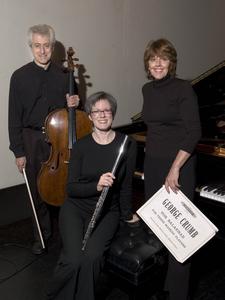

"Voice of the Whale" features, from left, cellist Emanuel Gruber, flutist Elizabeth Holler Ransom, and pianist Barbara McKenzie.
Inspired by American composer and Pulitzer Prize winner George Crumb's masterpiece Vox Balaenae, "ENDANGERED: The Voice of the Whale" is a multimedia awareness project about our responsibility to preserve and protect our marine environment. It has been acclaimed for its striking mystical quality and beauty.
The program, which features two films and live performances by flutist Elizabeth Holler Ransom, pianist Barbara McKenzie, cellist Emanuel Gruber, has been an insightful and exciting cultural arts field trip for North Carolina 5th graders. Ransom, a former Bristolian, hopes to bring the production to Northeast Tennessee.
The hour-long program includes a short video about the humpback whale, endangered sea turtles and the marine environment. These films set the stage for the live performance of Crumb's composition, which consists of a prologue, a set of variations named after geological eras, and an epilogue.
According to McKenzie, "This music represents classical music composed in our time. It is art-music for the concert stage. It evokes sounds and awe of nature."
She continues, "Crumb uses the same 12 pitches and building blocks as the music of Mozart or Beethoven such as rhythm, beat, melody and structure. He even uses the same traditional instruments as they might have used in their compositions: flute, cello and piano. However, the instrumental sounds are non-traditional...Upon first hearing, one immediately recognizes the altered sound quality of the flute, piano and cello. They are electrified, or amplified in order to create an other-worldly, watery sound."
The opening Vocalise (marked in the score "wildly fantastic, grotesque") is a kind of cadenza for the flutist, requiring Ransom to simultaneously play her instrument and sing into it. This combination of instrumental and vocal sound produces an eerie, surreal timbre, not unlike the sounds of the humpback whale. The cello evokes perhaps the moist vivid images: the screech of the seagull, the splash of primeval ocean waves, and the whisper of the mighty whale itself.
The musical score also calls for the musicians to wear black half-masks throughout the performance. According to the composer's notes, "the masks, by effacing a sense of human projection, will symbolize the powerful impersonal forces of nature." And, whenever possible, the work is performed under deep-blue stage lighting.
To prepare students for the performance, registered classes receive an education curriculum for in-class discussions. Teachers have the option to utilize a music curriculum, which includes a listening guide and CD of George Crumb's composition, or a science curriculum, which outlines the marine and environmental issues explored in the presentation.
According to Ransom, "The program has been so successful and appreciated by the school teachers, administrators, and students that both Chamber Music Wilmington and the American Music Festival (in Morehead City, NC) have decided to make it their signature educational offering each season for the next few years. Several other presenters, including The Paramount Center for the Arts in Bristol, are interested in hosting the program this season and next."
She concludes, "We (the trio of musicians) recognize its value as a multimedia performance as well as a program that succinctly and poignantly explores connections between environmental awareness / responsibility and artistic creations."
READ ON:
Arts & the Environment: Author Barbara Kingsolver & Family Get Back To Their Roots
Book Review: Animal, Vegetable, Mineral
Symphony & Planetarium present "Art of the Universe"
Art and Science merge in Hands On! Exhibit